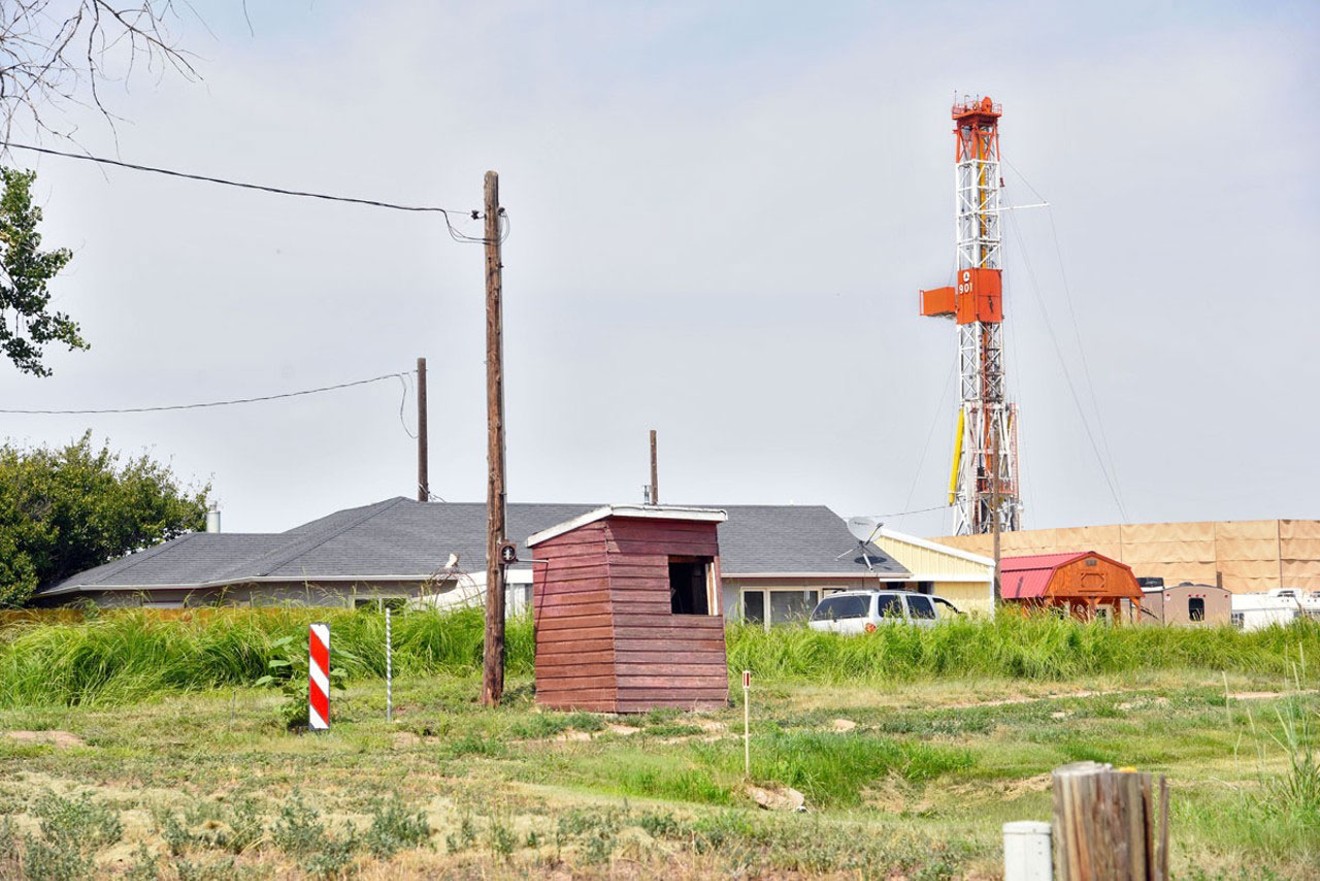Wading through the 380-page report on the health risks of oil and gas drilling released by the Colorado Department of Public Health and Environment on Thursday, October 17, requires parsing a lot of highly technical, carefully phrased findings.
“Benzene and 2-ethyltoluene were of primary concern, showing acute HQs above 10 at the selected receptors 500-ft downwind during development activities,” wrote the study’s authors, air-quality scientists with the consulting firm ICF International. “Maximum HQs were between 1 and 10 at the selected 2,000-ft receptor for benzene at all three sites (HQ=1.8–5.3; during all activities except for flowback at the Garfield County valley site and fracking at the NFR site, where HQs were below 1).”
In an article summarizing their findings in the peer-reviewed Journal of the Air & Waste Management Association, researchers distilled their conclusions into slightly more readable language: “Acute exposures were of greatest concern, primarily during O&G development and for a limited set of VOCs and critical-effect groups, sometimes at distances out to 2,000 feet from the well pad.”
Or, simplest of all, in the words of Colorado health officials: “The study found that there is a possibility of negative health impacts at distances from 300 feet out to 2,000 feet.”
The CDPHE’s long-awaited study, funded by the state at the recommendation of an oil and gas task force convened by former Governor John Hickenlooper in 2014, is based on air samples collected near Colorado fracking sites with the cooperation of drilling companies between 2013 and 2016. It uses statistical modeling to assess the risks of exposure to airborne pollutants for people in close proximity to drilling sites — a methodology that oil and gas groups, reacting to the study’s release on Thursday, rushed to criticize.
“Using modeled exposures instead of measured air quality data introduces uncertainties and limitations that may result in erroneous estimates of risk for a population,” Lynn Granger, executive director of the Colorado Petroleum Council, said in a statement.
Such modeling methods, however, are a common tool used by air quality researchers to estimate the real-world impacts of measured emissions. Collecting and analyzing ambient air samples is expensive and time-consuming, and recording enough individual measurements to fully account for all variables — time, distance, weather conditions, topography, human activity and more — isn’t feasible.
The study released Tuesday analyzed more than 5,000 air samples collected by researchers from Colorado State University in a pair of emissions studies completed in 2016. At the time, researchers and state health officials hailed the CSU data as one of the comprehensive sets of oil and gas emissions measurements ever recorded. Using modeling tools developed by the Environmental Protection Agency, the CDPHE’s new study extrapolated the measured data into millions of potential exposure scenarios — “many more than can be reasonably observed with monitoring,” its authors note.
The result is one of the most robust assessments of the health effects of oil and gas drilling yet completed — and specifically, one that raises the possibility that current "setback” distances mandated by the state aren’t enough to protect many Coloradans from short-term health risks.
But while the study is a major development — it’s been the object of a lot of anticipation and speculation since it was first announced three years ago — it’s far from the first attempt to settle the question of whether fracking threatens public health and the environment.
These latest findings are best understood in the full context of what we knew long before Thursday’s announcement. Here are three of the most important things to recognize about the impacts of fracking in Colorado and beyond.
1. Modern drilling technologies have led to much greater impacts.
Historically, so-called conventional oil and gas extraction involved drilling a series of vertical wells spaced roughly evenly across an oil field, and required relatively little “stimulation” to produce a steady flow of oil and gas. But about fifteen years ago, the industry underwent what has been dubbed the “Shale Revolution,” in which modern fracking methods, along with other technological advances like horizontal drilling, unleashed a wave of new, “unconventional” extraction.
Over the last decade, nearly all new drilling projects in the oil- and gas-rich Denver Basin, which stretches across much of northeast Colorado, have used unconventional shale drilling techniques. These projects are located on large “well pads” from which operators can drill dozens of wells, and involve multiple phases of drilling, stimulation and completion that can go on for months at a time.
It’s indisputable that these complex, heavy-industrial drilling methods have resulted in significantly higher emissions of airborne pollutants and other environmental effects — including noise, odors, dust, truck traffic and more — than conventional drilling. Studies have conclusively shown, for example, that facilities that use unconventional drilling emit far greater amounts of methane, a hydrocarbon and powerful greenhouse gas that is routinely co-emitted with other pollutants like volatile organic compounds (VOCs).
The study released Thursday by CDPHE confirms that unconventional extraction poses unique risks: It found that the highest probability of health hazards occurs during “flowback,” an unpredictable stage of modern drilling during which a volatile mix of hydrocarbons begins to flow out of a well after it has been fracked.
2. Residents near Colorado drilling sites have reported health impacts for years.
As CDPHE officials acknowledged at Thursday’s press conference, the health risks found by the new study are consistent with the real-world impacts that Colorado residents who live near drilling sites have been reporting to the agency for years.
“We’ve received, since 2015, about 750 health concerns that have been reported through our hotline,” state toxicologist Kristy Richardson said at the press conference. “About 60 percent of those concerns reported to us are things like headaches, nosebleeds, respiratory issues, skin irritation.”
The Colorado Oil and Gas Conservation Commission, too, has received nearly 3,000 complaints from residents impacted by fracking since January 2015, agency data shows. Issues identified in COGCC complaints range from noise violations and traffic impacts to many of the acute health problems identified as possible risks by the CDPHE’s new study.
“We had the house/windows opened while using our whole-house fan to efficiently cool the house,” complainant Mackenzie Carignan, who lives near the Livingston Pad in Broomfield, wrote on July 9. “In minutes, the whole house was flooded with heavy, noxious fumes like rubber, chemicals, maybe petroleum. My kids immediately reacted by gagging and my eyes began to burn (still burning). Throat burning, too.”
“Strong thick petroleum smell throughout the air around my home,” Erie resident Courtney Morrone reported in an April 2018 complaint. “Both my children complained immediately while playing outside saying it makes them feel sick.”
“Smell has been really bad, woke us up around 4:30 am, had to close windows,” reported John Shea, another Erie resident, in August 2017. “My wife has had a cough and nosebleeds for 5 weeks.”
“Strong petrochemical odor is prevalent,” Kevin Dinstell reported in December 2016. “My wife, son, and I have all experienced headaches, coughing, and other respiratory difficulties.”
The CDPHE study also helps substantiate a health effect anecdotally reported by residents impacted by fracking: high levels of benzene in their blood, which several residents have found after undergoing blood tests. One of the most significant risks assessed by the study, which researchers identified as a possible hazard at distances up to 2,000 feet, is “hematologic toxicity associated with benzene exposure.”
3. Hundreds of studies have found links between oil and gas development and health and environmental risks.
The modeling analysis released by CDPHE this week is one of the first of its kind, but it's far from the only scientific evaluation of the impacts of fracking. In the introduction to their journal article, researchers write that they reviewed nine different studies that "correlated proximity to O&G development with adverse health outcomes at different stages of life."
Several of these studies were conducted on the Front Range by teams led by Lisa McKenzie, a researcher at the Colorado School of Public Health. McKenzie's research has identified both short-term health risks and possible links to more serious impacts like childhood cancers and low birth weights.
McKenzie has been a frequent target of criticism from Colorado oil and gas groups for her work, but there's an extensive body of existing scientific literature that has reached similar conclusions. Physicians for Social Responsibility, an environmental advocacy group, maintains a compendium of fracking-related research that lists more than 1,500 studies of the effects of unconventional oil and gas development on air quality, water quality, public health and more.
In a 2016 article in the journal PLOS One, researchers analyzed nearly 700 peer-reviewed studies of the impacts of fracking, and found that "84% of public health studies contain findings that indicate public health hazards, elevated risks, or adverse health outcomes.” A more recent analysis, published earlier this year in the Oxford Research Encyclopedia of Global Public Health, also reviewed hundreds of studies and reached a similar conclusion.
"What we found pushes back against the narratives we often hear that say we don't know enough about the health impacts yet," Irena Gorski, the study's co-author, told Environmental Health News. "We have enough evidence at this point that these health impacts should be of serious concern to policymakers interested in protecting public health."
[
{
"name": "Air - MediumRectangle - Inline Content - Mobile Display Size",
"component": "12017618",
"insertPoint": "2",
"requiredCountToDisplay": "2"
},{
"name": "Editor Picks",
"component": "17242653",
"insertPoint": "4",
"requiredCountToDisplay": "1"
},{
"name": "Inline Links",
"component": "18838239",
"insertPoint": "8th",
"startingPoint": 8,
"requiredCountToDisplay": "7",
"maxInsertions": 25
},{
"name": "Air - MediumRectangle - Combo - Inline Content",
"component": "17261320",
"insertPoint": "8th",
"startingPoint": 8,
"requiredCountToDisplay": "7",
"maxInsertions": 25
},{
"name": "Inline Links",
"component": "18838239",
"insertPoint": "8th",
"startingPoint": 12,
"requiredCountToDisplay": "11",
"maxInsertions": 25
},{
"name": "Air - Leaderboard Tower - Combo - Inline Content",
"component": "17261321",
"insertPoint": "8th",
"startingPoint": 12,
"requiredCountToDisplay": "11",
"maxInsertions": 25
}
]












